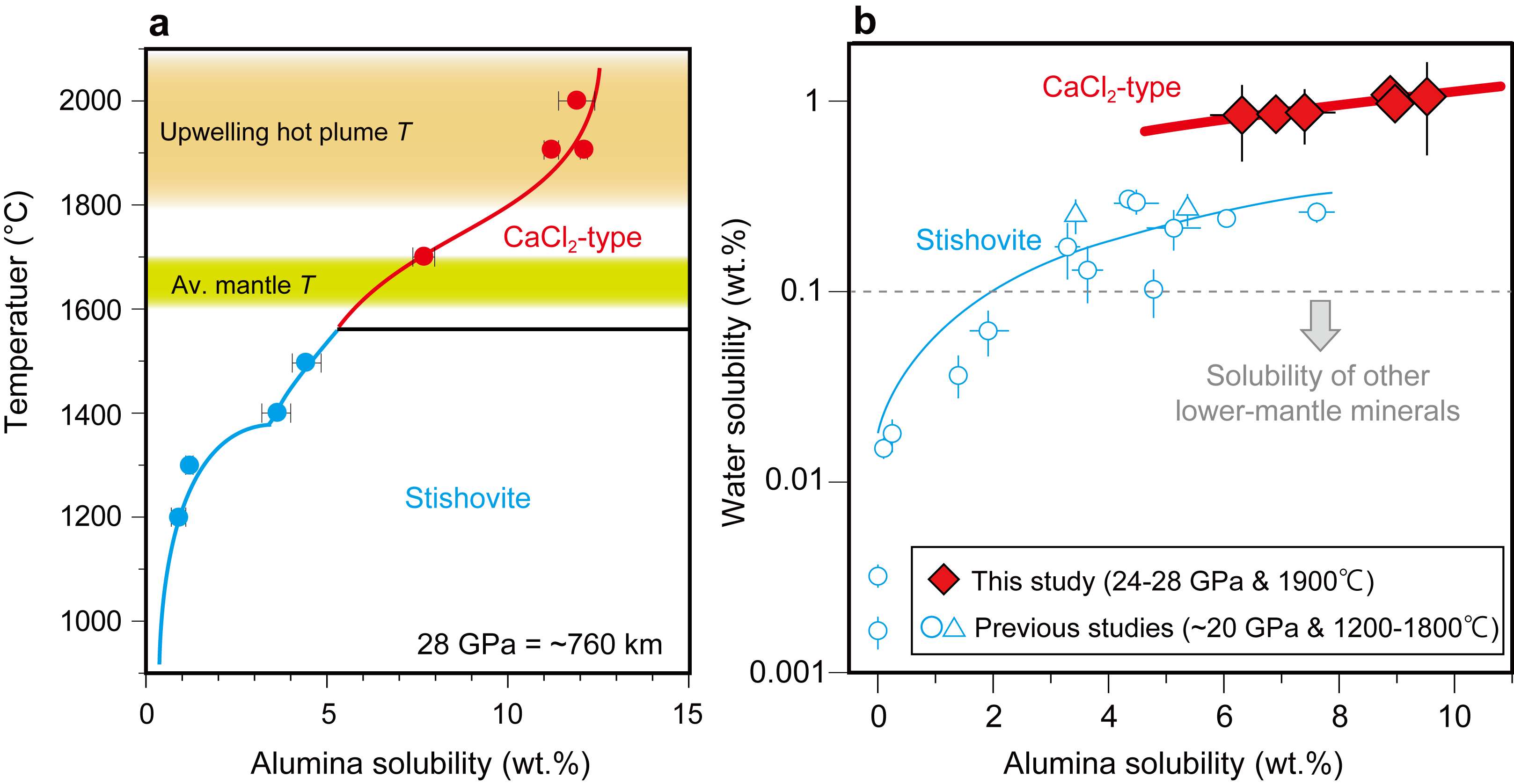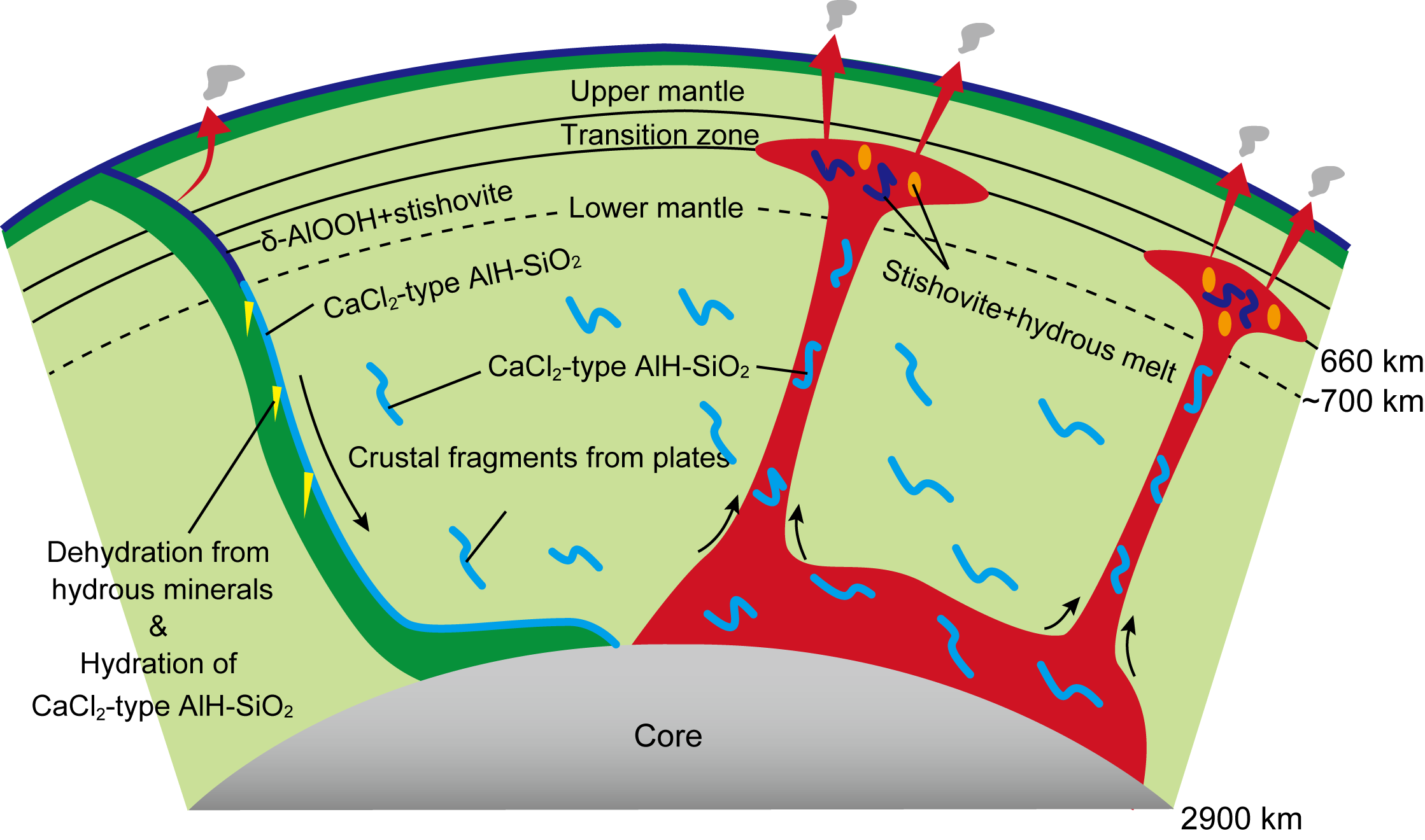Aluminous silica: A major water carrier in the lower mantle - Dr. Takayuki Ishii
OCTOBER 26, 2022
Water is transported by oceanic plates into the Earth's deep interior and changes the properties of minerals and rocks, affecting the Earth's internal material cycle and environmental evolution since the formation of the Earth. An international research group led by Dr. Takayuki Ishii and Dr. Ho-kwang Mao (Center for High Pressure Science and Technology Advanced Research, HPSTAR), Bayerisches Geoinstitut, University of Bayreuth, Germany, and Tohoku University, Japan, reveals that aluminous silicas play a major role as a water carrier in the lower mantle. They determined the alumina and water contents of silica minerals, which are important minerals in the basaltic crust of the upper part of a subducting plate. The results show that rutile-type silica (stishovite), which is widely stable in the upper part of the lower mantle, undergoes a phase transition to a CaCl2-type phase, when it contains water and alumina. The CaCl2-type aluminous silica can hold by more than 10 times water than other lower mantle minerals, even at very high temperatures in the lower mantle. This finding will lead to the elucidation of the origin of water in the lower mantle and the water cycle in the mantle. The results are published in the journal of PNAS.
Since the birth of the Earth, water has traveled through the Earth's surface and interior, triggering earthquakes and volcanic activity and affecting the evolution of the Earth's interior environment. It is estimated that the amount of water that can be stored in the Earth's interior is several times that of seawater on the Earth’s surface. Water (seawater) is transported to the Earth's interior by oceanic plates. To prevent water from leaking out of the plates, the minerals that make up the plates efficiently transport water by incorporating it into their crystal structures. It is thought that the minerals are transported by the plates to the lower mantle and then returned to the Earth’s surface by the upwelling plume. It is still not well understood how much water is stored in the Earth’s interior and how it returns to the Earth's surface. To understand these issues, it is important to know how much water mantle minerals can contain and how stably they can hold water.
It has been found that basalts found in oceanic island volcanoes such as hotspots, which are thought to have their source in the lower mantle, contain more water than other basalts. This suggests that the lower mantle plays the role of a major reservoir of water. However, previous high-temperature and high-pressure experiments have shown that the main lower mantle minerals that make up peridotite in the lower part of the subducting plate can hold very little water. Therefore, it is highly likely that water subducted into the lower mantle is stored in the minerals in basaltic crusts, which is the upper layer of the plate.
In this study, we focused on silica minerals, which is abundant in basaltic crusts. Although this mineral has been proposed to contain large amounts of water, water solubility in aluminous silica, which more likely exists in basaltic crusts since basalt is also rich in alumina, has not been intensively investigated in lower mantle conditions.
We have synthesized aluminous silica single crystals of high quality at uppermost lower mantle conditions by high temperature and high pressure experiments, and determined their precise water content by infrared spectroscopy. As a result, we found that the amount of alumina in silica increases with temperature, and that above 1700°C, the average temperature of the mantle, rutile-type silica (stishovite), which is stable at the top of the lower mantle, undergoes a phase transition to a CaCl2-type phase (Figure 1a). The CaCl2-type aluminous silica contains a larger amount (more than 1 wt.%) of water than stishovite, even above the average mantle temperature (Figure 1b). This is more than 10 times the water content that other lower mantle minerals can hold. Since the alumina content increases with temperature, the water content is also expected to increase in proportion to temperature. Previously reported mantle minerals release water with increasing temperature: their water content generally decreases with temperature. Since temperature increases with depth in the Earth's interior, this property implies that the water-holding capacity of minerals decreases with depth.

Fig. 1. (a) Alumina solubility in rutile-type (stishovite) and CaCl2-type silicas with increasing temperature at 28 GPa. (b) Relationship between alumina and water contents in stishovite and CaCl2-type silicas.
When water is released from minerals, it reacts with rocks to form hydrous magma, which separates from the plate and moves to the surface. Therefore, the depth at which minerals release water is considered to be the upper limit of water transport depth. Therefore, it has been pointed out that in the lower mantle, which is particularly hot, minerals cannot hold water and may not be able to transport water. Contrary to this property, the minerals synthesized in this study have a water content that increases with temperature and can hold large amounts of water even under the hottest plume conditions in the mantle. In addition, water released from other minerals is not separated from the plate, but is re-captured by aluminous silica in the basaltic layer of the plate, allowing water to be transported into the deep mantle without loss of water. Furthermore, the plume can also transport water again from the lower mantle to the upper mantle. Therefore, CaCl2-type aluminous hydrous silica may be the most promising water carrier in the lower mantle. In the transition zone and upper mantle, a reverse phase transition from the CaCl2-type phase to stishovite occurs, and water is thought to be released from silica as water-holding capacity in aluminous silica decreases. The local structures of the mantle discovered so far, such as the seismic low-velocity layer just below the transition zone-lower mantle boundary, plume ponding at the boundary, and the hydrous transition zone, are thought to be explained by the presence of water, and the behavior of aluminous hydrous silica can successfully explain these phenomena.

Fig. 2. Mantle convection including water by hydrous aluminous silicas.
地球表面的水通过大洋板片的俯冲输送到地球深部,从而改变地球深部矿物构成及其性质,影响了地球自形成以来的内部物质循环和地表环境演化。然而,地球内部储存了多少水,以及水在地表和地球深部之间如何循环?这些问题至今都是未解之谜。由北京高压科学研究中心的Ishii研究员带领的国际研究团队,揭示了含铝二氧化硅在向下地幔输送水的过程中起到了关键作用。二氧化硅矿物是构成俯冲板片上部的玄武质地壳的重要矿物,研究团队通过测量二氧化硅矿物的铝和水含量,证明了在下地幔顶部稳定存在的金红石型结构的二氧化硅(斯石英),在含有水和氧化铝的情况下,发生了向CaCl2型结构(超斯石英)的相变。即使下地幔温度非常高,含铝超斯石英的水含量也是其他下地幔矿物的10倍以上。这一发现将有助于阐明下地幔水的来源和地幔水循环。相关ch成果发表于10月24日的《美国国家科学院院刊》。
